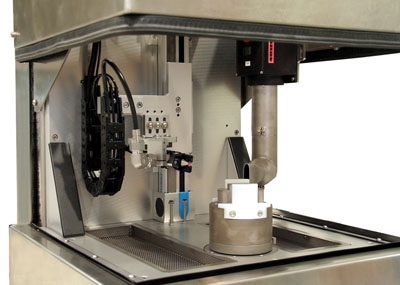
Whether it's rotationally symmetrical workpieces such as shafts, pistons, bearings, and toothed parts, or medical devices such as implants, if strict tolerances have to be met, each product is carefully checked by optical measurement during the production process. But to do this, component surfaces have to be clean. quattroClean from ACI AG is a solution, an inline and fully-automated innovative cleaning cell.
To ensure product quality and cost-efficiency, machined precision parts are often optically measured. The closer the measurement system can be moved to the machining center, the better the results that are obtained. However, contaminants left on the parts' surfaces, such as processing media residues, chips and flaky burrs, can be a problem. They may cause measurement errors and result in parts being rejected unnecessarily. To avoid this, it makes sense to integrate a needs-oriented cleaning step directly between the machining process and measurement step, and this can be achieved using the innovative modular cleaning solution quattroClean from ACI AG.
The system can be integrated into a fully-automated production line in the smallest of spaces or used as a stand-alone device. Components can be advanced into the machine using any common automation system. Standardized interfaces allow for easy integration of the serial system controller into a master computer. All relevant process parameters are recorded and stored automatically, or sent to the master computer as required.
Available in three different sizes, the new cleaning cell carries out a dry, selective cleaning step on the surface to be measured, either in the one-piece flow of the production line or in a rotary indexing table. Tailored to specific application requirements, the cell is fitted with a CO2 snow-jet system from acp, a company belonging to the ACI Group. The environmentally-neutral cleaning technology uses liquid carbon dioxide as a medium, which is generated as a by-product from chemical processes and from generating energy with biomass.
Liquid carbon dioxide is guided through the patented two-component ring nozzle of the acp system where it expands on exiting to form fine snow crystals. These are then bundled by a jacketed jet and accelerated to supersonic speed. A combination of thermal, mechanical, sublimation and solvent mechanisms take place as the easy-to-focus jet impacts at minus 78.5°C on the surface to be cleaned,. These four mechanisms enable the QuattroClean system to reliably remove film-like contaminants, e.g. residues of cooling lubricants, processing oils and polishing paste, or particulate contaminants, such as chips, flaky burrs and dust. At the same time, the low degree of hardness of the snow crystals makes sure that even sensitive and finely-structured surfaces are cleaned gently.
Thanks to the aerodynamic power of the compressed air jet, the detached contaminants are instantly carried away from the component surface. Together with the gaseous sublimated carbon dioxide, the contaminants are then removed from the cleaning cell by an integrated suction unit. On completion of the cleaning process, parts are completely dry and can be measured immediately.
Among other things, the quattroClean system is used by Mahle GmbH to clean the lateral surfaces of engine pistons in an inline process prior to their optical measurement. Parts are handled by a robot which places the pistons both in the cleaning cell and later in the measuring system. To do this, the robot is fitted with two grippers: one for contaminated parts and one for cleaned parts. To avoid measurement errors, parts are re-tempered after cleaning. The quattroClean system operates in the one-piece flow of the production line and is capable of cleaning 11 cm2/sec.
To determine the exact process parameters required for each application, material property and type of contamination, e.g. volume flow of compressed air and carbon dioxide as well as blasting time cleaning tests are performed. This enables the quattroClean system to be adapted for use in coating, assembly and packaging lines as well as in conjunction with other processes where clean surfaces are required. Depending on the task at hand, ACI also designs cleaning cells for cleanroom use. In order to perform cleaning tests under cleanroom conditions, ACI has its own application center with an ISO Class 7 cleanroom (which can be adapted to ISO Class 6 if required). Equipment is also available for determining cleanliness levels before and after cleaning.
Contact Details
Related Glossary Terms
- hardness
hardness
Hardness is a measure of the resistance of a material to surface indentation or abrasion. There is no absolute scale for hardness. In order to express hardness quantitatively, each type of test has its own scale, which defines hardness. Indentation hardness obtained through static methods is measured by Brinell, Rockwell, Vickers and Knoop tests. Hardness without indentation is measured by a dynamic method, known as the Scleroscope test.
- machining center
machining center
CNC machine tool capable of drilling, reaming, tapping, milling and boring. Normally comes with an automatic toolchanger. See automatic toolchanger.
- polishing
polishing
Abrasive process that improves surface finish and blends contours. Abrasive particles attached to a flexible backing abrade the workpiece.






